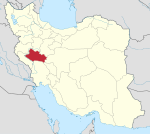Kuhdasht County (Persian: شهرستان کوهدشت) is in Lorestan province, Iran. Its capital is the city of Kuhdasht.[3]
History
After the 2011 National Census, Rumeshkan District was separated from the county in the establishment of Rumeshkan County.[4]
Demographics
Population
At the time of the 2006 census, the county's population was 209,821 in 43,159 households.[5] The following census in 2011 counted 218,921 people in 52,799 households.[6] The 2016 census measured the population of the county as 166,658 in 45,155 households.[2]
Administrative divisions
Kuhdasht County's population history and administrative structure over three consecutive censuses are shown in the following table.
| Administrative Divisions | 2006[5] | 2011[6] | 2016[2] |
|---|---|---|---|
| Central District | 121,775 | 129,899 | 124,015 |
| Gol Gol RD | 12,150 | 12,704 | 11,235 |
| Kuhdasht-e Jonubi RD | 16,923 | 16,981 | 16,907 |
| Kuhdasht-e Shomali RD | 7,183 | 7,287 | 6,782 |
| Kuhdasht (city) | 85,519 | 92,927 | 89,091 |
| Darb-e Gonbad District | 13,017 | 12,662 | 10,621 |
| Boluran RD | 5,012 | 4,650 | 3,082 |
| Darb-e Gonbad RD | 5,886 | 5,821 | 5,408 |
| Darb-e Gonbad (city) | 2,119 | 2,191 | 2,131 |
| Kuhnani District[a] | 21,786 | 21,433 | 19,292 |
| Kuhnani RD[b] | 11,596 | 7,160 | 6,665 |
| Zirtang RD[c] | 6,444 | 6,031 | 4,859 |
| Kuhnani (city)[d] | 3,746 | 8,242 | 7,768 |
| Rumeshkan District[e] | 35,595 | 38,701 | |
| Rumeshkan-e Gharbi RD[f] | 11,376 | 11,938 | |
| Rumeshkan-e Sharqi RD[g] | 19,418 | 21,587 | |
| Chaqabol (city) | 4,801 | 5,176 | |
| Tarhan District | 17,648 | 16,101 | 12,730 |
| Tarhan-e Gharbi RD | 8,847 | 7,807 | 5,526 |
| Tarhan-e Sharqi RD[h] | 5,531 | 5,094 | 3,909 |
| Garab (city) | 3,270 | 3,200 | 3,295 |
| Total | 209,821 | 218,921 | 166,658 |
| RD = Rural District | |||
See also
![]() Media related to Kuhdasht County at Wikimedia Commons
Media related to Kuhdasht County at Wikimedia Commons
Notes
- ^ Formerly Kunani District[4]
- ^ Formerly Kunani Rural District[4]
- ^ Formerly Rumeshkan-e Gharbi Rural District[7]
- ^ Formerly Kunani[4]
- ^ Transferred to Rumeshkan County[4]
- ^ Renamed Suri Rural District[4]
- ^ Renamed Rumeshkan Rural District[4]
- ^ Formerly Tarhan Rural District
References
- ^ OpenStreetMap contributors (2 January 2025). "Kuhdasht County" (Map). OpenStreetMap (in Persian). Retrieved 2 January 2025.
- ^ a b c Census of the Islamic Republic of Iran, 1395 (2016): Lorestan Province. amar.org.ir (Report) (in Persian). The Statistical Center of Iran. Archived from the original (Excel) on 12 October 2020. Retrieved 19 December 2022.
- ^ Mousavi, Mirhossein (c. 2024) [Approved 11 November 1367]. Creation of Kuhdasht County under the citizenship of Lorestan province and creation of Tarhan and Rumeshkan Districts. lamtakam.com (Report) (in Persian). Ministry of the Interior, Board of Ministers. Proposal 1.5.53.14395; Notification. Archived from the original on 20 January 2024. Retrieved 20 January 2024 – via Lam ta Kam.
- ^ a b c d e f g Rahimi, Mohammad Reza (c. 2015) [Approved 2 May 1392]. Divisional reforms in Lorestan province. law.dotic.ir (Report) (in Persian). Ministry of the Interior, Council of Ministers. Proposal 4/1/42/24457. Archived from the original on 28 September 2015. Retrieved 21 November 2023 – via Laws and Regulations Portal of the Islamic Republic of Iran.
- ^ a b Census of the Islamic Republic of Iran, 1385 (2006): Lorestan Province. amar.org.ir (Report) (in Persian). The Statistical Center of Iran. Archived from the original (Excel) on 20 September 2011. Retrieved 25 September 2022.
- ^ a b Census of the Islamic Republic of Iran, 1390 (2011): Lorestan Province. irandataportal.syr.edu (Report) (in Persian). The Statistical Center of Iran. Archived from the original (Excel) on 19 January 2023. Retrieved 19 December 2022 – via Iran Data Portal, Syracuse University.
- ^ Habibi, Hassan (22 July 1374) [Approved 7 September 1374]. Divisional reforms in Lorestan province. rc.majlis.ir (Report) (in Persian). Ministry of the Interior, Political and Defense Commission of the Government Board. Proposal 1.4.42.5226; Letter 93808-907; Notification 9113/T15428K. Archived from the original on 28 September 2015. Retrieved 28 August 2023 – via Islamic Parliament Research Center.















You must be logged in to post a comment.